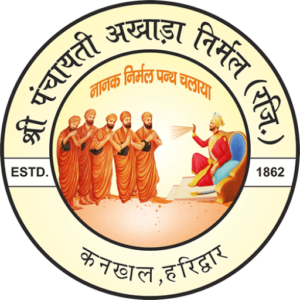Understanding the Nirmal Panth & Sanatan Sikh Philosophy
Exploring the Sacred Convergence of Sikh Wisdom and Vedantic Teachings
🕉️ Introduction
India is a land of spiritual confluence—where seemingly distinct philosophies often merge to create deeper truths. One such beautiful synthesis is the Nirmal Panth, a unique spiritual tradition born from the vision of Guru Gobind Singh Ji, combining the wisdom of the Guru Granth Sahib with the philosophical depth of Vedanta and Sanatan Dharma.
The Nirmala sect, central to the Panchayati Akhara Nirmal, reflects this remarkable spiritual harmony. It champions a path of purity, learning, and universal truth, earning its rightful place in both Sikh history and Hindu-Vedic discourse.
🔱 The Birth of Nirmal Panth – Guru Gobind Singh Ji’s Vision
In the late 17th century, as spiritual and cultural threats loomed, Guru Gobind Singh Ji recognized the need to preserve and promote India’s sacred traditions with intellectual strength. He selected five Sikh disciples and sent them to Kashi (Varanasi)—the epicenter of Sanskrit learning—to study Vedic literature, Upanishads, Puranas, and other Sanatan scriptures.
These disciples became the first Nirmala saints—a name derived from “Nirmal,” meaning pure or untainted. Their mission was not conversion but synthesis: to understand, harmonize, and teach Sikh values through the lens of Vedantic thought.
📚 Doctrinal Foundations of Nirmal Panth
The Nirmal Panth ideology is founded on four key principles:
Adhyatma (Spiritual Purity)
Nirmala saints emphasize inner purity, restraint, humility, and a disciplined ascetic life dedicated to divine realization.
Adhyayan (Scriptural Study)
Followers devote their lives to studying the Guru Granth Sahib, Bhagavad Gita, Upanishads, Vedanta Sutras, and Smritis, bridging the Sikh and Hindu scriptural worlds.
Adhyapan (Teaching & Preaching)
As spiritual scholars, Nirmalas share their learnings through pravachans, satsangs, and scriptural debates, promoting a universal, inclusive approach to God.
Seva (Selfless Service)
At the heart of Sanatan Sikhism lies seva—feeding the hungry, sheltering pilgrims, and serving humanity without distinction.
Vedanta and Sikh Convergence
Though Sikhism and Vedanta arise from different contexts, their core spiritual goals overlap:
Sikhism (Gurmat) Vedanta (Sanatan Dharma)
Belief in Ek Onkar (One Supreme) Belief in Brahman (Universal Consciousness)
Emphasis on Naam Simran (Remembrance of God) Emphasis on Jnana (Knowledge of Self)
Guru Granth Sahib as the eternal Guru Vedas & Upanishads as guiding scriptures
Rejection of ritualism Emphasis on inner realization
The Nirmal Panth doesn’t force a merger—it creates a bridge, allowing seekers to embrace both traditions through learning, contemplation, and disciplined living.
Sanatan Sikhism: Not a Contradiction, but a Harmony
The term Sanatan Sikhism might sound contradictory at first—but in the context of Nirmal Panth, it signifies eternal truths as revealed through both Sikh Gurus and Sanatan scriptures.
Nirmala saints believe:
The Guru Granth Sahib is the highest authority and spiritual guide.
The Vedas and Upanishads offer philosophical clarity and tools for self-realization.
There is no conflict in integrating these teachings—rather, they enrich each other.
This pluralistic approach doesn’t dilute Sikhism. It strengthens it by rooting it in India’s timeless traditions, allowing it to converse with other philosophies on equal terms.
Training Nirmala saints in both Gurmukhi and Sanskrit
Hosting satsangs, scriptural dialogues, and vedic learning programs
Publishing important works such as “Shri Nirmal Panth Prakash”, preserving doctrinal heritage
Participating in Kumbh Melas as a leading spiritual institution blending Sikh and Sanatan identity
Practicing austerity, self-study, and service, guided by saints like Acharya Mahamandaleshwar Gyan Dev Singh Ji
✨ Why Nirmal Panth Matters Today
In today’s fragmented spiritual world, the Nirmal Panth offers unity—a philosophy that does not divide based on creed or caste, but invites all to experience truth through learning, discipline, and service.
Whether you’re a student of philosophy, a spiritual seeker, or a devotee of Guru Gobind Singh Ji, the Nirmal Panth shows a path that is pure, learned, and balanced.
📖 Conclusion
The Nirmal Panth is not a deviation from Sikhism—it is an extension of Guru Gobind Singh Ji’s vision for a scholarly, spiritually evolved community rooted in eternal truths. In blending the Guru Granth Sahib with Vedantic scriptures, the Nirmal tradition offers a timeless, inclusive, and transformative spiritual path.
At the heart of this lies the Panchayati Akhara Nirmal—a sanctuary where Sanatan Sikh philosophy is lived, preserved, and shared with the world.

